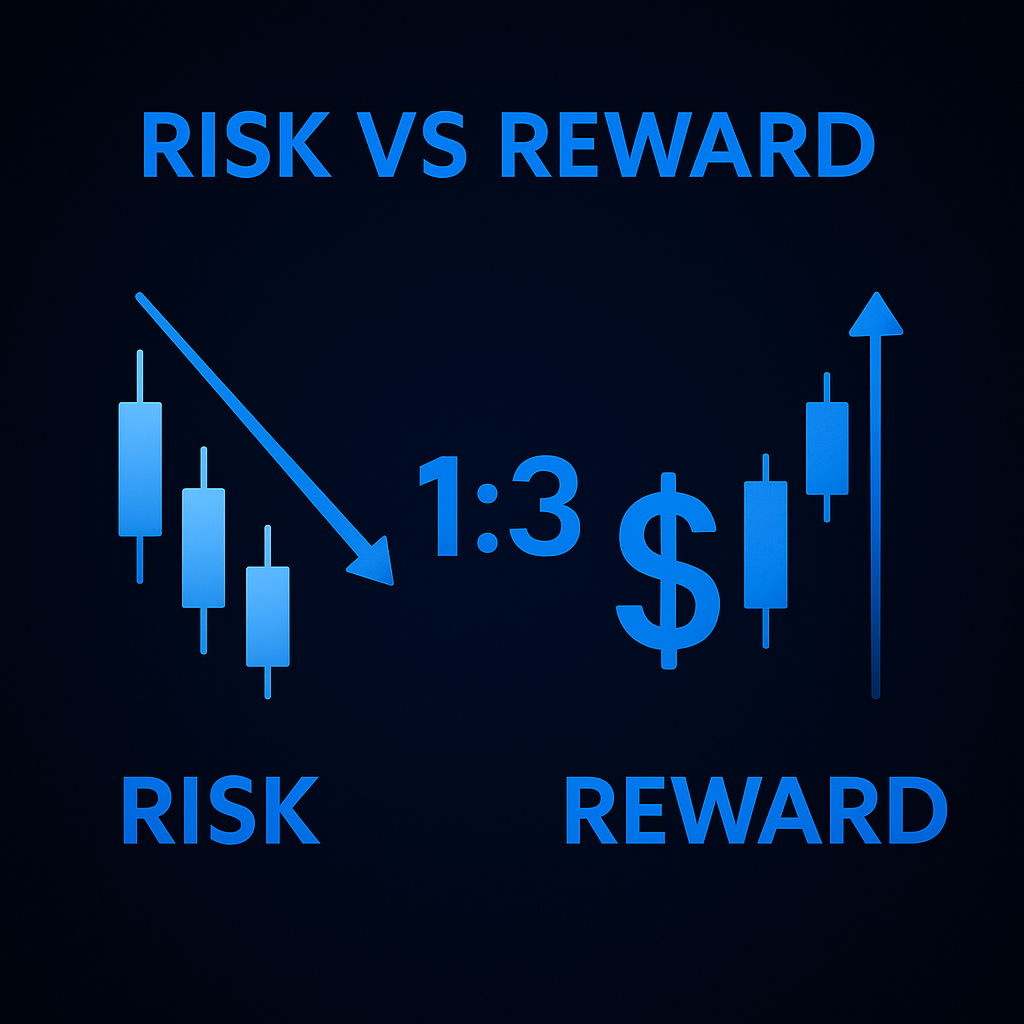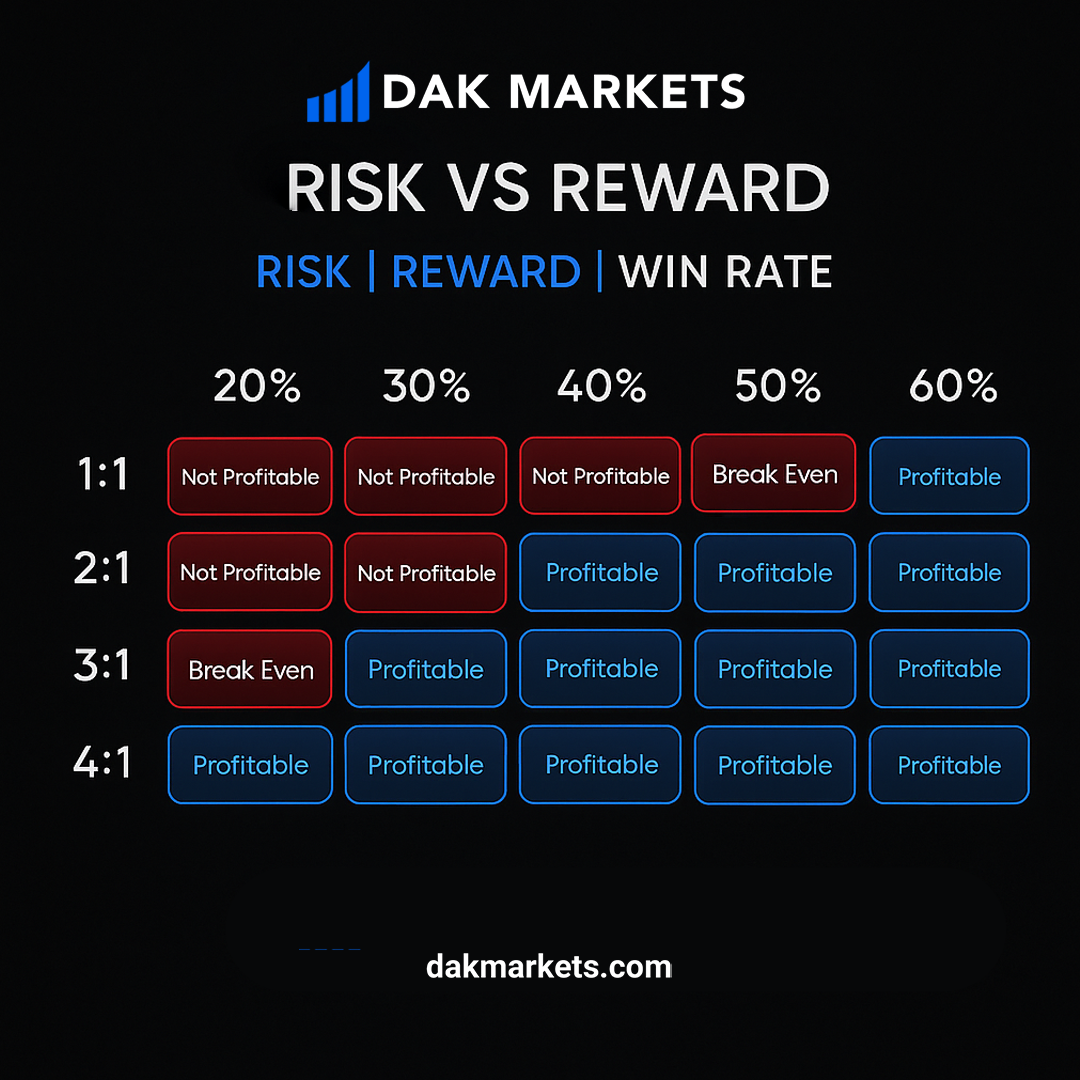Risk vs Reward: The Key to Profitable Trading
In trading, success doesn’t just come from picking the right direction of the market — it comes from managing your risk and reward effectively. Too many traders focus only on win rates, celebrating how often they are right, while overlooking whether their trading strategy is mathematically sustainable.
At DAK Markets, we emphasize that understanding and applying the risk-to-reward ratio (R:R) is one of the most powerful ways to secure long-term profitability.

What Is Risk vs Reward?
The risk-to-reward ratio (R:R) measures the amount of potential loss you are willing to take compared to the potential gain you aim to achieve in a trade.
- Risk → The money you could lose if the trade goes against you (your stop-loss).
- Reward → The profit you expect if the trade goes in your favor (your take-profit).
For example:
- If you risk $100 to potentially gain $100, your R:R is 1:1.
- If you risk $100 to potentially gain $300, your R:R is 1:3.

This simple ratio influences whether you can survive inevitable losing streaks and still stay profitable in the long run.
Why Risk vs Reward Matters More Than Win Rate
Many traders believe that a high win rate automatically means profitability. In reality, this is misleading. Let’s compare two traders:
- Trader A wins 70% of trades but only trades at 1:1. After losses, commissions, and spreads, they might barely break even.
- Trader B wins just 40% of trades but uses a 1:3 ratio. Even with fewer wins, they end up profitable over time.
👉 This shows that a strong R:R can outweigh a lower win rate.
The Profitability Matrix
To better understand this concept, let’s visualize it with a risk vs reward vs win rate matrix:
- 1:1 ratio → Profitable only with a 60% win rate or higher.
- 2:1 ratio → Profitable at just a 40% win rate.
- 3:1 ratio → Even a 30% win rate can be profitable.
- 4:1 ratio or higher → You can afford to lose more trades than you win and still make money.
📌 In other words, the higher your reward relative to risk, the lower your win rate needs to be to remain consistently profitable.
How to Apply Risk vs Reward in Trading
1. Define Your Risk Before Entering
Never enter a trade without knowing your maximum acceptable loss. Place a stop-loss and stick to it.
2. Calculate Your Reward Potential
Before executing, ensure that your potential reward is at least 2x your risk. This way, even if you lose more trades than you win, you can still come out ahead.
3. Track Your Average R:R
Keep a trading journal. Calculate the average R:R across your trades. If your ratio is consistently low (like 1:1 or less), you’ll need a very high win rate to stay profitable.
4. Avoid Emotional Trading
Traders often cut winning trades too early or let losing trades run too long. Sticking to your planned R:R helps remove emotional decision-making.
Risk vs Reward in Forex Trading
In forex markets, where volatility and liquidity can shift quickly, understanding R:R is even more important:
- Scalpers may aim for lower R:R (1:1 or 1:1.5) but rely on extremely high win rates.
- Swing traders often use 1:2, 1:3, or higher, allowing them to capture larger market moves with fewer trades.
- Professional money managers almost always structure trades to maintain favorable R:R to preserve capital and grow accounts sustainably.
At DAK Markets, our advanced trading platforms make it easy to predefine stop-loss and take-profit levels, helping traders lock in their planned ratios.
FAQs About Risk vs Reward
Q1: What is the best R:R ratio for trading?
There is no universal “best” ratio, but most professional traders recommend at least 1:2 or 1:3 for sustainable profitability.
Q2: Can you be profitable with 1:1?
Yes, but you would need a win rate above 50%, ideally closer to 60–65%. This is difficult for most traders to maintain long term.
Q3: How do I calculate my win rate?
Divide the number of winning trades by the total trades taken. For example, 40 wins out of 100 trades = 40% win rate.
Q4: Should I always go for the highest R:R possible?
Not necessarily. Extremely high R:R (like 1:10) setups may be rare and unrealistic. Balance consistency with favorable ratios.
Final Thoughts
Successful trading isn’t about being right all the time — it’s about managing your risk so that your winners outweigh your losers. By understanding the relationship between risk, reward, and win rate, you shift the odds in your favor and trade with discipline rather than emotion.
At DAK Markets, we provide next-gen trading technology and insights to help you apply these principles in real time. Whether you’re new to trading or scaling your strategy, mastering risk vs reward can be the difference between long-term success and short-lived results.
👉 Ready to trade smarter? Start today with DAK Markets.

